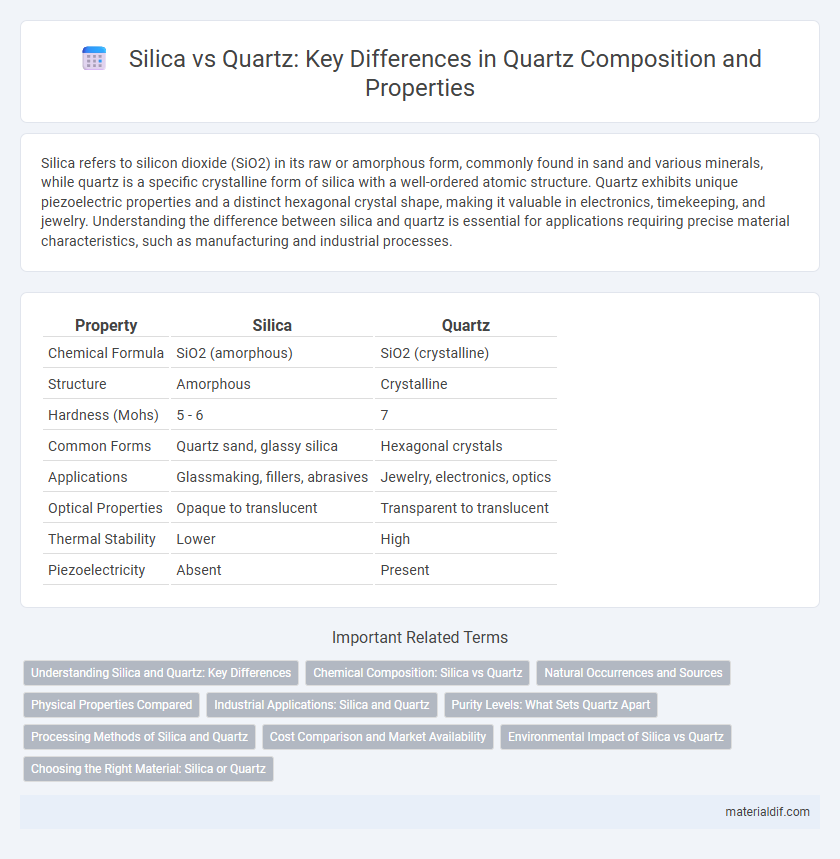Silica refers to silicon dioxide (SiO2) in its raw or amorphous form, commonly found in sand and various minerals, while quartz is a specific crystalline form of silica with a well-ordered atomic structure. Quartz exhibits unique piezoelectric properties and a distinct hexagonal crystal shape, making it valuable in electronics, timekeeping, and jewelry. Understanding the difference between silica and quartz is essential for applications requiring precise material characteristics, such as manufacturing and industrial processes.
Table of Comparison
| Property | Silica | Quartz |
|---|---|---|
| Chemical Formula | SiO2 (amorphous) | SiO2 (crystalline) |
| Structure | Amorphous | Crystalline |
| Hardness (Mohs) | 5 - 6 | 7 |
| Common Forms | Quartz sand, glassy silica | Hexagonal crystals |
| Applications | Glassmaking, fillers, abrasives | Jewelry, electronics, optics |
| Optical Properties | Opaque to translucent | Transparent to translucent |
| Thermal Stability | Lower | High |
| Piezoelectricity | Absent | Present |
Understanding Silica and Quartz: Key Differences
Silica primarily refers to silicon dioxide (SiO2), a fundamental chemical compound found in various forms, with quartz being its most common crystalline structure. Quartz is a specific mineral variety of silica characterized by its ordered atomic arrangement and is widely used in electronics, glassmaking, and construction due to its hardness and stability. Understanding the distinctions between silica as a broader category and quartz as a defined mineral aids in applications ranging from industrial manufacturing to health and safety regulations related to silica exposure.
Chemical Composition: Silica vs Quartz
Silica primarily refers to silicon dioxide (SiO2) in its natural or synthetic form, encompassing various crystalline and amorphous structures. Quartz is a specific crystalline form of silica distinguished by its well-ordered crystal lattice and hexagonal structure. Both share the same chemical composition, SiO2, but quartz exhibits unique physical properties due to its crystallinity compared to amorphous silica forms.
Natural Occurrences and Sources
Silica primarily exists as silicon dioxide (SiO2) in various natural forms, with quartz being the most common crystalline form found abundantly in Earth's crust. Quartz forms in igneous, metamorphic, and sedimentary rocks through processes like crystallization from molten magma or precipitation from hydrothermal solutions. While silica can also appear as amorphous forms like opal or chalcedony, quartz represents the stable, well-ordered crystalline silica widely sourced from mines and quarries worldwide.
Physical Properties Compared
Quartz is a crystalline mineral composed primarily of silicon dioxide (SiO2), while silica generally refers to silicon dioxide in various forms, including amorphous and crystalline states. Quartz exhibits a well-defined crystal structure, offering hardness of 7 on the Mohs scale, distinct cleavage, and a specific gravity around 2.65, whereas silica can vary in physical properties depending on its form, with amorphous silica lacking the organized crystal lattice and often presenting lower hardness and density. The distinct arrangement of silicon and oxygen atoms in quartz results in higher mechanical strength and transparency compared to many forms of silica.
Industrial Applications: Silica and Quartz
Silica, primarily composed of silicon dioxide in an amorphous form, is extensively used in manufacturing glass, ceramics, and silicon chips due to its high purity and thermal stability. Quartz, a crystalline variant of silica, finds critical applications in precision instruments like oscillators, resonators, and optical devices because of its piezoelectric properties and consistent crystal structure. Industrial processes leverage silica's versatility and quartz's unique electro-mechanical characteristics to optimize performance in electronics, construction materials, and high-tech manufacturing.
Purity Levels: What Sets Quartz Apart
Quartz exhibits higher purity levels compared to standard silica, primarily composed of nearly 99.95% silicon dioxide (SiO2). This exceptional purity results from advanced processing techniques that eliminate common impurities found in natural silica. The superior purity of quartz enhances its performance in industrial applications, including electronics, optics, and precision glass manufacturing.
Processing Methods of Silica and Quartz
Silica and quartz undergo distinct processing methods tailored to their mineral forms; silica is typically processed through thermal treatment and grinding to produce industrial-grade silicon dioxide powder. Quartz processing often involves crushing, washing, and flotation to isolate pure quartz crystals for electronic and optical applications. Both methods prioritize purity and particle size control to meet specific industry standards such as semiconductor manufacturing and glass production.
Cost Comparison and Market Availability
Quartz generally costs more than silica due to its natural formation process and higher demand in construction and electronics industries. Silica, abundant and widely available as sand or industrial byproducts, offers a lower-cost alternative for applications requiring silicon dioxide. Market availability of silica remains broad and consistent, while quartz supply can fluctuate based on mining regulations and extraction difficulty.
Environmental Impact of Silica vs Quartz
Silica, primarily found in sand, generates significant dust emissions during mining and processing, contributing to air pollution and respiratory health risks, whereas quartz, being a crystalline form of silica, generally involves more energy-intensive extraction methods with higher carbon footprints. Quartz mining often leads to habitat disruption and groundwater contamination due to chemical use, whereas natural silica sources typically pose lower risks if responsibly managed. Environmental regulations increasingly target silica dust control and sustainable quartz mining practices to mitigate their respective ecological impacts.
Choosing the Right Material: Silica or Quartz
Choosing between silica and quartz depends on the intended application, as quartz is a crystalline form of silica with superior durability and clarity, making it ideal for countertops and jewelry. Silica in its amorphous form offers flexibility for industrial uses such as glass manufacturing and chemical reactions. Understanding the specific properties, like hardness, thermal resistance, and optical clarity, ensures selecting the appropriate material enhances performance and longevity.
Silica vs Quartz Infographic

 materialdif.com
materialdif.com